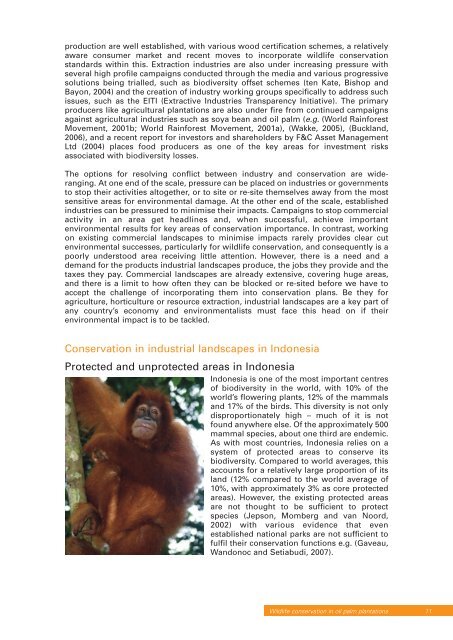The conservation of tigers and other wildlife in oil palm plantations
The conservation of tigers and other wildlife in oil palm plantations
The conservation of tigers and other wildlife in oil palm plantations
Create successful ePaper yourself
Turn your PDF publications into a flip-book with our unique Google optimized e-Paper software.
production are well established, with various wood certification schemes, a relatively<br />
aware consumer market <strong>and</strong> recent moves to <strong>in</strong>corporate <strong>wildlife</strong> <strong>conservation</strong><br />
st<strong>and</strong>ards with<strong>in</strong> this. Extraction <strong>in</strong>dustries are also under <strong>in</strong>creas<strong>in</strong>g pressure with<br />
several high pr<strong>of</strong>ile campaigns conducted through the media <strong>and</strong> various progressive<br />
solutions be<strong>in</strong>g trialled, such as biodiversity <strong>of</strong>fset schemes (ten Kate, Bishop <strong>and</strong><br />
Bayon, 2004) <strong>and</strong> the creation <strong>of</strong> <strong>in</strong>dustry work<strong>in</strong>g groups specifically to address such<br />
issues, such as the EITI (Extractive Industries Transparency Initiative). <strong>The</strong> primary<br />
producers like agricultural <strong>plantations</strong> are also under fire from cont<strong>in</strong>ued campaigns<br />
aga<strong>in</strong>st agricultural <strong>in</strong>dustries such as soya bean <strong>and</strong> <strong>oil</strong> <strong>palm</strong> (e.g. (World Ra<strong>in</strong>forest<br />
Movement, 2001b; World Ra<strong>in</strong>forest Movement, 2001a), (Wakke, 2005), (Buckl<strong>and</strong>,<br />
2006), <strong>and</strong> a recent report for <strong>in</strong>vestors <strong>and</strong> shareholders by F&C Asset Management<br />
Ltd (2004) places food producers as one <strong>of</strong> the key areas for <strong>in</strong>vestment risks<br />
associated with biodiversity losses.<br />
<strong>The</strong> options for resolv<strong>in</strong>g conflict between <strong>in</strong>dustry <strong>and</strong> <strong>conservation</strong> are widerang<strong>in</strong>g.<br />
At one end <strong>of</strong> the scale, pressure can be placed on <strong>in</strong>dustries or governments<br />
to stop their activities altogether, or to site or re-site themselves away from the most<br />
sensitive areas for environmental damage. At the <strong>other</strong> end <strong>of</strong> the scale, established<br />
<strong>in</strong>dustries can be pressured to m<strong>in</strong>imise their impacts. Campaigns to stop commercial<br />
activity <strong>in</strong> an area get headl<strong>in</strong>es <strong>and</strong>, when successful, achieve important<br />
environmental results for key areas <strong>of</strong> <strong>conservation</strong> importance. In contrast, work<strong>in</strong>g<br />
on exist<strong>in</strong>g commercial l<strong>and</strong>scapes to m<strong>in</strong>imise impacts rarely provides clear cut<br />
environmental successes, particularly for <strong>wildlife</strong> <strong>conservation</strong>, <strong>and</strong> consequently is a<br />
poorly understood area receiv<strong>in</strong>g little attention. However, there is a need <strong>and</strong> a<br />
dem<strong>and</strong> for the products <strong>in</strong>dustrial l<strong>and</strong>scapes produce, the jobs they provide <strong>and</strong> the<br />
taxes they pay. Commercial l<strong>and</strong>scapes are already extensive, cover<strong>in</strong>g huge areas,<br />
<strong>and</strong> there is a limit to how <strong>of</strong>ten they can be blocked or re-sited before we have to<br />
accept the challenge <strong>of</strong> <strong>in</strong>corporat<strong>in</strong>g them <strong>in</strong>to <strong>conservation</strong> plans. Be they for<br />
agriculture, horticulture or resource extraction, <strong>in</strong>dustrial l<strong>and</strong>scapes are a key part <strong>of</strong><br />
any country’s economy <strong>and</strong> environmentalists must face this head on if their<br />
environmental impact is to be tackled.<br />
Conservation <strong>in</strong> <strong>in</strong>dustrial l<strong>and</strong>scapes <strong>in</strong> Indonesia<br />
Protected <strong>and</strong> unprotected areas <strong>in</strong> Indonesia<br />
Indonesia is one <strong>of</strong> the most important centres<br />
<strong>of</strong> biodiversity <strong>in</strong> the world, with 10% <strong>of</strong> the<br />
world’s flower<strong>in</strong>g plants, 12% <strong>of</strong> the mammals<br />
<strong>and</strong> 17% <strong>of</strong> the birds. This diversity is not only<br />
disproportionately high – much <strong>of</strong> it is not<br />
found anywhere else. Of the approximately 500<br />
mammal species, about one third are endemic.<br />
As with most countries, Indonesia relies on a<br />
system <strong>of</strong> protected areas to conserve its<br />
biodiversity. Compared to world averages, this<br />
accounts for a relatively large proportion <strong>of</strong> its<br />
l<strong>and</strong> (12% compared to the world average <strong>of</strong><br />
10%, with approximately 3% as core protected<br />
areas). However, the exist<strong>in</strong>g protected areas<br />
are not thought to be sufficient to protect<br />
species (Jepson, Momberg <strong>and</strong> van Noord,<br />
2002) with various evidence that even<br />
established national parks are not sufficient to<br />
fulfil their <strong>conservation</strong> functions e.g. (Gaveau,<br />
W<strong>and</strong>onoc <strong>and</strong> Setiabudi, 2007).<br />
Wildlife <strong>conservation</strong> <strong>in</strong> <strong>oil</strong> <strong>palm</strong> <strong>plantations</strong> 11

















